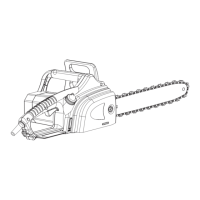into your saw. As a chain saw user, you should take several steps to keep your cutting
jobs free from accident or injury.
e. Kickback is the result of tool misuse and/or incorrect operating procedures or
conditions and can be avoided by taking proper precautions as given below:
- Maintain a rm grip, with thumbs and ngers encircling the chain saw
handles, with both hands on the saw and position your body and arm to
allow you to resist kickback forces. Kickback forces can be controlled by the
operator, if proper precautions are taken. Do not let go of the chain saw.
- Do not overreach and do not cut above shoulder height. This helps prevent
unintended tip contact and enables better control of the chain saw in unexpected
situations.
- Only use replacement bars and chains specied by the manufacturer.
Incorrect replacement bars and chains may cause chain breakage and/or kickback.
- Follow the manufacturer’s sharpening and maintenance instructions for the
saw chain. Decreasing the depth gauge height can lead to increased kickback.
6. Important safety
1). How to read symbols. (See Fig. 1)
2). Danger! Beware of kickback!
Warning! Used to warn that an unsafe procedure
should not be performed.
Warning! Kickback can lead to dangerous loss of
control of the chain saw and result in serious or fatal
injury to the saw operator or to anyone standing
close by. Always be alert because rotational kickback
and pinch kickback are major chain saw operational
dangers and the leading cause of most accidents.
Image 1--- Beware of kickback.
Image 2--- Do not attempt to hold saw with one hand.
Image 3--- Avoid bar nose contact.
Image 4--- Hold saw properly with both hands. Never
use the machine
with one hand: the chain brake does not work!
Beware of rotational kickback. (See Fig. 2a)
A= Kickback path
B= Kickback reaction zone
Fig. 1
Fig. 2a

